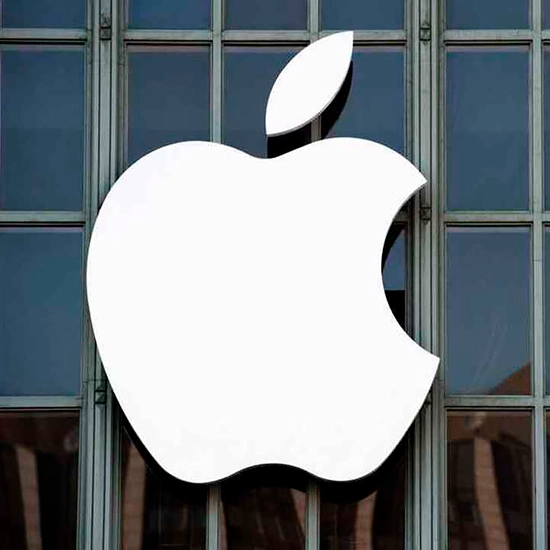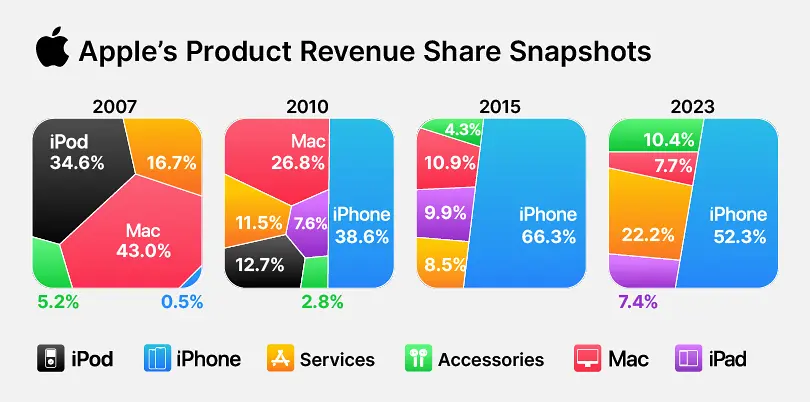Apple Inc, a titan in the technology sector, has long been a focal point for investors worldwide. This analysis delves into the company’s market position, influencing factors, and the potential implications for its stock performance.
Company Overview
Key facts:
Founded: April 1, 1976
Founders: Steve Jobs, Steve Wozniak, Ronald Wayne
Current CEO: Tim Cook (since 2011)
Stock symbol: AAPL (NASDAQ)
Product Portfolio:
Apple’s revenue streams stem from a diverse range of products and services:
iPhone: Smartphone line
Mac: Personal computer range
iPad: Tablet devices
Wearables, Home, and Accessories: Includes Apple Watch, AirPods, HomePod
Services: App Store, Apple Music, Apple TV+, iCloud, Apple Pay

Historical Milestones
Key Events in Apple’s History:
| Year | Event |
|---|---|
| 1976 | Apple Computer Company founded |
| 1980 | Initial Public Offering (IPO) |
| 1984 | Introduction of the Macintosh |
| 2001 | Launch of iPod and iTunes |
| 2007 | iPhone debut |
| 2010 | iPad released |
| 2015 | Apple Watch introduced |
| 2019 | Launch of Apple TV+ streaming service |
| 2022 | Market cap reaches $3 trillion |
Market Situation

The technology sector, characterized by rapid innovation and intense competition, forms the backdrop for Apple’s operations.
Industry Overview
Key characteristics of the consumer electronics and software industry:
- High research and development expenditure
- Rapid technological advancements
- Short product lifecycles
- Global supply chains
- Intense patent competition
Competitive Landscape
Apple faces competition from various companies across its product lines:
- Smartphones: Samsung, Huawei, Xiaomi
- Personal Computers: Dell, HP, Lenovo
- Tablets: Samsung, Amazon, Microsoft
- Wearables: Fitbit, Samsung, Garmin
- Services: Spotify, Netflix, Google
Apple’s Market Position
Apple’s standing in key product categories:
| Product Category | Market Share |
| Smartphones | 17.2% |
| Tablets | 36.5% |
| Smartwatches | 30.1% |
| Personal Computers | 8.9% |
Note: Market share percentages are approximate and subject to change.
Influencing Factors
Internal Factors
Apple’s core strengths lie in its robust product innovation cycle, backed by substantial R&D investments. Solid financial performance fuels an aggressive corporate strategy, encompassing market expansion and product diversification. The company’s formidable brand strength, characterized by high customer loyalty and ecosystem lock-in, reinforces its market dominance.
External Factors
Macroeconomic conditions and regulatory landscapes significantly influence Apple’s operations. The company navigates evolving technological trends, intense competitive pressures, and geopolitical events that impact global supply chains and international trade dynamics. These external factors continually shape Apple’s strategic decisions and market positioning.
Analyst Opinions
Financial analysts offer varied perspectives on Apple’s stock performance. Here’s a synthesis of recent analyst views:
Bullish Perspective: John Smith, Global Tech Insights
“Apple’s ecosystem strategy and services growth present significant upside potential. The company’s ability to maintain high margins and customer loyalty suggests a strong long-term outlook.”
Key points:
Price target: $250
Rating: Buy
Catalyst: Services revenue growth and new product categories
Cautious Outlook: Sarah Johnson, Market Dynamics Research
“While Apple’s brand strength is undeniable, market saturation in key product categories and increasing regulatory scrutiny pose challenges. Investors should monitor these factors closely.”
Key points:
Price target: $200
Rating: Hold
Concerns: Smartphone market saturation and potential regulatory headwinds
Bearish View: Michael Chen, Tech Sector Analytics
“Apple’s reliance on the iPhone for a significant portion of its revenue creates vulnerability. The company needs to demonstrate stronger growth in non-iPhone categories to justify its current valuation.”
Key points:
Price target: $180
Rating: Underperform
Issues: iPhone dependency and challenges in emerging markets
Table: Analyst Recommendations Summary
| Analyst | Rating | Price Target |
|---|---|---|
| John Smith | Buy | $250 |
| Sarah Johnson | Hold | $200 |
| Michael Chen | Underperform | $180 |
Prospects and Risks
Evaluating Apple’s future requires consideration of both growth opportunities and potential challenges.
Growth Factors
Services Expansion
Potential for high-margin recurring revenue
Cross-selling opportunities within the ecosystem
Emerging Markets
Untapped smartphone markets in developing countries
Growing middle class in markets like India and Southeast Asia
Wearables and Accessories
Continued growth in Apple Watch and AirPods segments
Potential for new wearable technology categories
5G Adoption
Upgrade cycle driven by 5G-capable devices
Increased data consumption benefiting services segment
Healthcare Technology
Integration of health monitoring features in devices
Potential partnerships with healthcare providers
Risk Factors
Market Saturation
Slowing growth in mature smartphone markets
Challenges in maintaining high market share
Supply Chain Disruptions
Dependency on specific component suppliers
Geopolitical risks affecting manufacturing
Regulatory Challenges
Antitrust investigations in multiple jurisdictions
Potential changes to App Store policies and revenue model
Technological Shifts
Emergence of disruptive technologies
Failure to anticipate or adapt to new trends
Economic Downturns
Reduced consumer spending on premium products
Currency fluctuations impacting international sales
How to Buy Apple Shares
For investors interested in purchasing Apple stock, here’s a step-by-step guide:
1. Choose a Brokerage
– Consider factors like fees, research tools, and user interface
– Options include traditional brokers and online platforms
2. Open an Account
– Provide necessary personal information
– Complete identity verification process
3. Fund Your Account
– Transfer money from your bank account
– Consider starting with a smaller investment to familiarize yourself with the process
4. Place an Order
– Decide between market orders (buy at current price) or limit orders (set a maximum price)
– Determine the number of shares or dollar amount to invest
5. Monitor Your Investment
– Keep track of Apple’s financial reports and news
– Consider setting up alerts for significant price movements
Conclusion
Table: Apple Stock Analysis Summary
| Aspect | Assessment |
|---|---|
| Financial Strength | Strong |
| Market Position | Market Leader |
| Growth Potential | Moderate to High |
| Risk Level | Moderate |
| Analyst Consensus | Cautiously Optimistic |
Investors considering Apple shares should:
1. Evaluate their risk tolerance and investment goals
2. Consider Apple’s position within a diversified portfolio
3. Stay informed about industry trends and company developments
4. Be prepared for potential volatility in the tech sector
FAQ
How does Apple’s dividend policy affect its stock value?
Apple pays a quarterly dividend, which can attract income-focused investors. The company’s dividend policy, combined with its share buyback program, signals confidence in its financial stability and can support the stock price.
What impact does the iPhone product cycle have on Apple’s stock performance?
iPhone releases typically follow an annual cycle. The stock often experiences increased volatility around new iPhone announcements and initial sales reports, as the iPhone contributes significantly to Apple’s revenue.
How might changes in US-China relations affect Apple’s stock?
US-China relations can impact Apple’s stock due to the company’s reliance on Chinese manufacturing and the Chinese consumer market. Trade tensions or policy changes could affect production costs, supply chain efficiency, and sales in the Chinese market.
